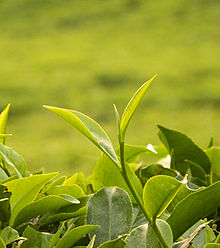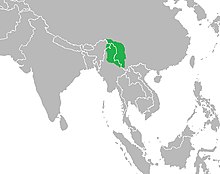
Back Teestruik Afrikaans ሻይ ቅጠል Amharic Camellia sinensis AN كاميليا صينية Arabic أتاي ARY كاميليا صينيه ARZ Camellia sinensis AST Çay (bitki) Azerbaijani چای (بیتکی) AZB Чай (растение) Bulgarian
| Camellia sinensis | |
|---|---|

| |

| |
| Camellia sinensis foliage | |
| Scientific classification | |
| Kingdom: | Plantae |
| Clade: | Tracheophytes |
| Clade: | Angiosperms |
| Clade: | Eudicots |
| Clade: | Asterids |
| Order: | Ericales |
| Family: | Theaceae |
| Genus: | Camellia |
| Species: | C. sinensis
|
| Binomial name | |
| Camellia sinensis | |

| |
| Native range of Camellia sinensis | |
| Synonyms[2] | |
|
Camellia sinensis
| |
Camellia sinensis is a species of evergreen shrub or small tree in the flowering plant family Theaceae. Its leaves, leaf buds, and stems can be used to produce tea. Common names include tea plant, tea shrub, and tea tree (unrelated to Melaleuca alternifolia, the source of tea tree oil, or the genus Leptospermum commonly called tea tree).
White tea, yellow tea, green tea, oolong, dark tea (which includes pu-erh tea) and black tea are all harvested from one of two major varieties grown today, C. sinensis var. sinensis and C. s. var. assamica,[3] but are processed differently to attain varying levels of oxidation with black tea being the most oxidized and white being the least.[4] Kukicha (twig tea) is also harvested from C. sinensis, but uses twigs and stems rather than leaves.
- ^ Rivers, M.C.; Wheeler, L. (2018). "Camellia sinensis". IUCN Red List of Threatened Species. 2018: e.T62037625A62037628. doi:10.2305/IUCN.UK.2018-1.RLTS.T62037625A62037628.en. Retrieved 19 November 2021.
- ^ Cite error: The named reference
FOCwas invoked but never defined (see the help page). - ^ ITIS Standard Report Page Camellia Sinensis Archived 19 November 2022 at the Wayback Machine retrieved 2009-03-28.
- ^ Preedy, V.R. (2013). Tea in Health and Disease Prevention. Elsevier Science. pp. 199–200. ISBN 978-0-12-384937-3. Archived from the original on 10 November 2023. Retrieved 24 February 2022.
